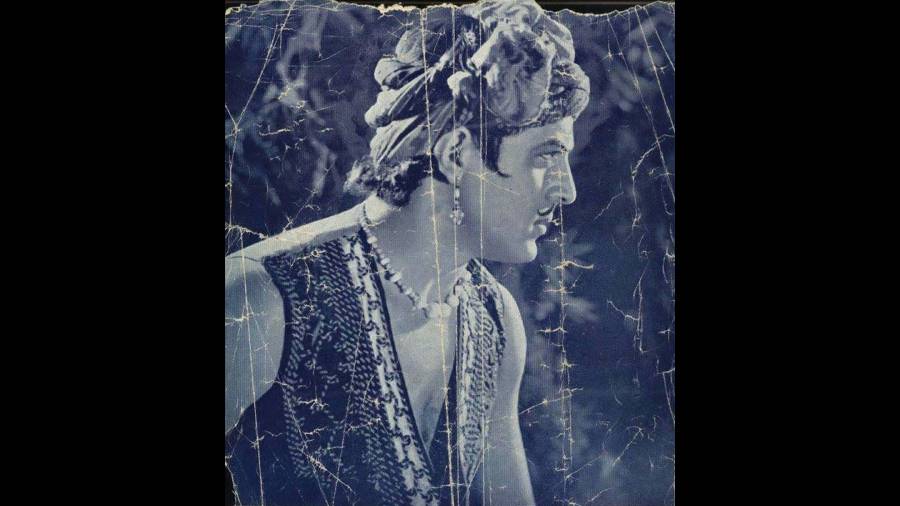Peshawar / Calcutta (now Kolkata), BRITISH INDIA :
The Telegraph tells the story of another Pathan from Peshawar who galloped his way into Indian cinema, and then galloped away much too soon.

Let’s start from the very beginning, a time when celluloid was just opening up to the light of day. And in those first few pages of the history of Indian cinema, one place finds mention again and again — Peshawar.
The city, some say, derives its name from the Sanskrit Purushapura, meaning the City of Men. Perhaps by divine direction, it truly went on to gain a reputation as the city of stars. Prithviraj Kapoor, Raj Kapoor, Dilip Kumar, Vinod Khanna… were all born in Peshawar or nearabouts. Shah Rukh Khan’s clan too belongs there. It was also home to Gul Hamid, a Pathan who shone bright on the silver screen like few stars did.
Born in 1905 in Pirpai village, Hamid was known for his handsome looks. Nasir Shah, whose great grandmother was the actor’s sibling, reveals how a young Hamid galloped into the movies, quite literally. “He was a constable with the British police in Peshawar and was sent to Lahore as part of a contingent to manage a political event — a public address by Gandhiji. This was around 1928-29,” Shah tells The Telegraph over phone from Australia, where he works as an engineer.
A member of the mounted police, Hamid was ambling on horseback after work when he came upon a film shoot. The director of the unit was the famous A.R. Kardar, and the scene that of an abduction — of the heroine by the villain, also on horseback. Seeing a helpless woman being chased, Hamid — unaware of what shooting really meant — rode his horse straight into it and brought the villain down. “Kardar was struck by the handsome Pathan and talked him into working in his film,” Shah says.
That’s how he debuted in Sarfarosh, a silent film made in 1930. Hamid was also part of the first Punjabi feature film, Heer Ranjha (1932). After working in several films in Lahore, he followed Kardar to Calcutta, which was then one of cinema’s biggest laboratories. He acted in Debaki Bose’s Bengali film Seeta (1934), which became the first Indian talkie to receive international recognition, at the Venice Film Festival. He was also part of Yahudi ki Ladki (1933), directed by Premankur Atorthy. And then, Hamid made his way to Bombay, to another budding industry for some more action.
“I would call him the first real stud of Indian cinema; his appearance was just so perfect,” says Shivendra Singh Dungarpur, filmmaker, archivist and restorer, “…the kind of star, say, John Wayne was in the Westerns of Hollywood.” Dungarpur shares an anecdote from those times. “When Bose saw the astonishingly good-looking man from Peshawar, he wondered what kind of a role would suit him… and thus Hamid got to play the character of a god, as if to justify his looks.”
The film also featured Prithviraj Kapoor as Rama and Durga Khote as Sita.
In fact, the entire story of Hamid’s career — and untimely death — is in many ways quite incredible. The actor died when he was all of 31, after battling Hodgkin’s disease for a few months. But by then he had acted in 14 films, earning for himself the title of Sitar-e-Hind or Star of Hindustan.
Hamid fell in love with and married the Calcutta-born Patience Cooper, his co-star in many films. But he had to keep it a secret from his family back in Peshawar for obvious reasons.
“He was even engaged to a simple, traditional girl of his mother’s choice,” says Shah. His family came to know about the marriage only after Hamid’s death, when his brothers broke open a chest full of letters shared between the two. It was almost like he was living a double life, feels Shah, “His family clearly had no idea of his stature or the big picture.”
The film world in those days was ruled by the trinity of Prithviraj Kapoor, K.L. Saigal and Hamid. “The scenario would be much altered if Hamid hadn’t died so young,” says Dungarpur. And although very little documentation survives, Hamid — given his pairing up with Cooper — was quite the star people were talking about. “I recall seeing magazines from the era with photographs of couples such as them, and Devika Rani and Himangshu Rai,” says he.
Perhaps the most significant of all of Hamid’s films was Khyber Pass (1936), which he also scripted and directed. “It was made in Peshawar; it was his effort to showcase Pashtun culture,” says Shah.
In an interview reminiscing those days — it is available on YouTube — Prithviraj Kapoor talks about Hamid, “Badi khoobiyat thhi usme, bahut pyara admi thha… Woh mujhey bade bhaiyya pukarte thhe (Hamid was a talented man and lovable man, he would address me as big brother).”
As a very sick Hamid lay on his deathbed, Kapoor went to visit his friend one last time. Shah’s grandfather, who was then a little boy, witnessed a conversation between the two that could very well have been lifted straight out of a script.
Kapoor asked, “Gul Hamid, kaise ho… how are you?”
And Hamid answered, “Andar se aag ki tarah garam aur bahar se barf ki tarah thanda (Burning like fire itself from within and as cold as ice on the outside).”
It is said that cinema never again saw an actor with Gul Hamid’s looks.
source: http://www.telegraphindia.com / The Telegraph Online / Home> Culture / by Paromita Kar / October 31st, 2021








